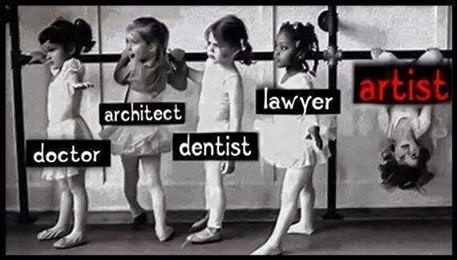It started with this image:
 |
| (sorry, I do not know the original artist; I found it floating on FB. If you know the photographer or captioner, please let me know) |
You know the old cliche about artists as free souls, beating to their own drums, etc, etc, etc. Of course the artist is the one that doesn't conform to the rules while the others are just boring, conventional people who will have boring conventional lives.
No. If you ask me which one of those little girls will be the dancer, I would answer the one that is concentrating, paying attention to the teacher and practicing her little heart out to attain perfection. The one who loves dancing so much she is willing to give up almost anything to dance, who will train every day until her feet bleed.
This is what a dancer's feet look like. This isn't someone who is just goofing off, this is someone who is willing to hurt a lot for her art.
Who will be an author? The one who not only observes people and lives, who has great creative ideas for a story and has something to say about both, but, mainly, the one who sits down and writes. Their first story will be terrible, their second story will be terrible and so on. But if she practices her craft, if she is willing to read over her work (painful as it may be) and evaluate it objectively, if she is open to advice and weighs that advice, she will improve.
Which one will be a painter? The one who works all day at a job to pay her bills but gets home and sits down in front of the easel for a solid 4 or 5 hours of work, dreaming of the day she can support herself with her art. The one who can hear 50 "nos" but take it as a learning experience, to improve her form of expression.
It isn't enough to "have something to say" in order to be artist. It is also necessary to be able to say it. That requires practice and hard work to develop your skills. Goofing off doesn't make an artist, it gets you kicked out of a serious class.
Pure technique also doesn't make an artist, it makes a craftsman. Artistry is combining what your soul wants to share with the skills to make it come true.
Artists may be introverts or extroverts, the class clown or the bookworm. The class clown may become a lawyer, a doctor or an artist. In the end, it is about having something to communicating and working hard to express it, understanding a chosen medium so it can share the message, knowing the rules well enough to break them for a cause and observing the world to extract that one new thing, large or small, that no one had noticed before.
No. If you ask me which one of those little girls will be the dancer, I would answer the one that is concentrating, paying attention to the teacher and practicing her little heart out to attain perfection. The one who loves dancing so much she is willing to give up almost anything to dance, who will train every day until her feet bleed.
This is what a dancer's feet look like. This isn't someone who is just goofing off, this is someone who is willing to hurt a lot for her art.
Who will be an author? The one who not only observes people and lives, who has great creative ideas for a story and has something to say about both, but, mainly, the one who sits down and writes. Their first story will be terrible, their second story will be terrible and so on. But if she practices her craft, if she is willing to read over her work (painful as it may be) and evaluate it objectively, if she is open to advice and weighs that advice, she will improve.
Which one will be a painter? The one who works all day at a job to pay her bills but gets home and sits down in front of the easel for a solid 4 or 5 hours of work, dreaming of the day she can support herself with her art. The one who can hear 50 "nos" but take it as a learning experience, to improve her form of expression.
It isn't enough to "have something to say" in order to be artist. It is also necessary to be able to say it. That requires practice and hard work to develop your skills. Goofing off doesn't make an artist, it gets you kicked out of a serious class.
Pure technique also doesn't make an artist, it makes a craftsman. Artistry is combining what your soul wants to share with the skills to make it come true.
Artists may be introverts or extroverts, the class clown or the bookworm. The class clown may become a lawyer, a doctor or an artist. In the end, it is about having something to communicating and working hard to express it, understanding a chosen medium so it can share the message, knowing the rules well enough to break them for a cause and observing the world to extract that one new thing, large or small, that no one had noticed before.





